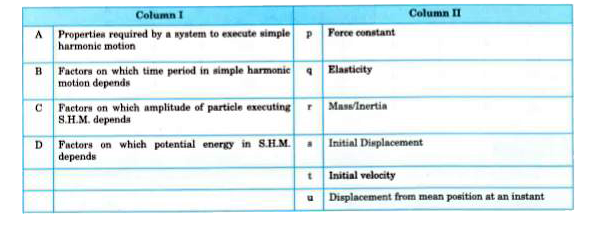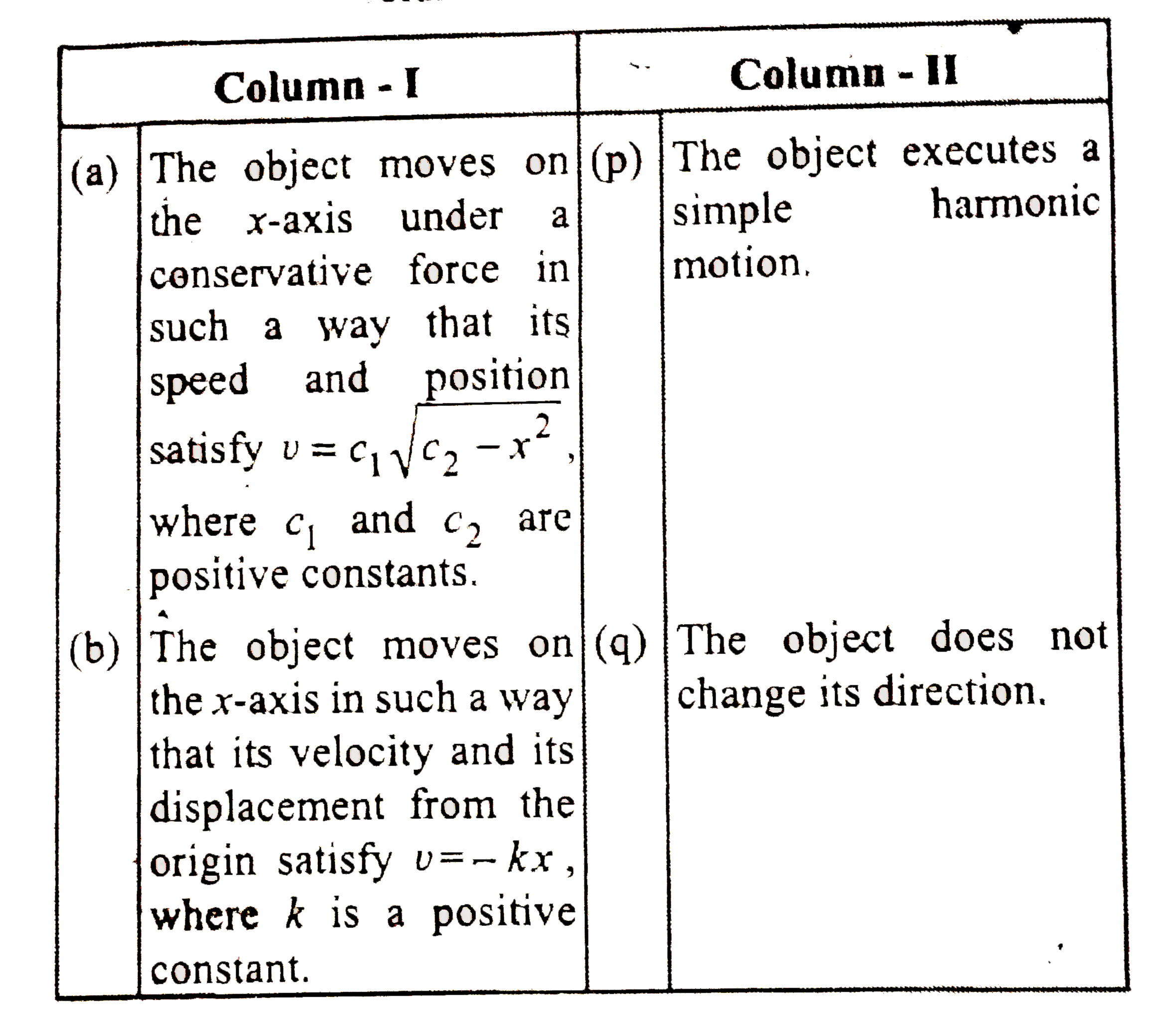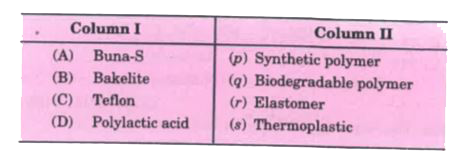Column - I describes some situations in which a small object moves. Column - II describes some characteristics of these motions. Match the situations in Column - I with the characteristics in Column - II
Column -IColumn -II(A) The object moves on the axis under a conservative(P) The object executes a simpleforce in such a way that its ''speed'' and position''harmonic motion.satisfyv=c1√c2−x2wherec1andc2are positiveconstants.(B) The object moves on the x-axis in such a way that(Q) The object does not change itsits velocity and its displacement from the origin satisfydirectionv=-kx, where k is a positive constant(C ) The object is attached to one end of a mass-less(R ) The kinetic energy of the objectspring of a given spring constant. The other end of thekeeps on decreasingspring is attached to the ceilling of an elevator. Initiallyeverything is at rest. Teh elevator starts going upwardswith a constant acceleration a. The motion of theobject is observed from the elevator during the periodit maintains this acceleration(D) The object is projected from the earth's surface(S) The object can change its directionvertically upwards with a speed2√GMeRewhereonly once.Meis the mass of the earth andReis the radius of theearth Neglect forces from objects other than the earth.
The correct Answer is:(A) P; (B) Q,R; (C ) P; (D) Q,R
(a) The velocity of a Particle excuting simple harmorince motion is related to displacement x as
v=ω√A2−x2
Where ω ands A are positive constants. The given above equation. Hence the body executes.
(b) If follows from equation v = -kx that v = 0 at x = 0, i.e. object comes to rest at x=0. Thus of object starting from a negative x valuescomes to rest x = 0 , its velocity (and hence kinetic energy) decrease with time. Hence correct choices are (q) are (r ).
(c ) For an observer in the refrence frame of the elevator, a constant force acts on the object. This a pseudo force. Hence the motion of the object remains simple harmonic, which is choice (p).
(d) Since the speed of the object is √2 time the escape velocity (ve=√2GMe/Re) the direction of motion of the object does not charge (since the force exerted by objects other than the earth are neglected) and the speed of the object keeps decreasing. Hence the correct choices are (q) and (r ).
Topper's Solved these Questions
- BOOK - BANSALCHAPTER - GRAVITATIONEXERCISE - EXERCISE -4 Section - B6videos
GRAVITATION
- BOOK - BANSALCHAPTER - GRAVITATIONEXERCISE - EXERCISE -3 [Miscellaneous Exercise]35videos
GRAVITATION
- BOOK - BANSALCHAPTER - CENTRE OF MASS & MOMENTUM CONSERVATIONEXERCISE - EXERCISE-4 (SECTION-B) (JEE-ADVANCED Previous Year Questions)8videos
CENTRE OF MASS & MOMENTUM CONSERVATION
- BOOK - BANSALCHAPTER - HEAT TRANSFEREXERCISE - Exercise89videos
HEAT TRANSFER
Similar Questions
Column I describles some situtations in which a small object moves. Column II describes some characteristics of these motions. Match the situations in Column I with the characteristics in Column II.
 View Solution
View SolutionColumn I describes some situations in which a small object moves. Column II describes some characteristics of these motion. Match the situtions in column I with the characteristics in column II.

 View Solution
View Solution
Knowledge Check
- Question 1 - Select One
Math the carbohydrate in Column I with its characteristic given in Column II
 AA-s, B-r, C-p , D-qBA-p, B-q, C-r, D-sCA-r, B-s, C-p, D-qDA-s, B-r, C-q, D-p
AA-s, B-r, C-p , D-qBA-p, B-q, C-r, D-sCA-r, B-s, C-p, D-qDA-s, B-r, C-q, D-p
Column I describes some situations in which a small object moves. Column II describes some characteristics of these motion. Match the situtions in column I with the characteristics in column II.

 View Solution
View SolutionMatch the polymers in Column I with the characteristic listed in Column II.
 View Solution
View SolutionMatch the molecule in Column I with the characteristic in Column II
 View Solution
View SolutionMatch the molecules in column I with their characteristics in column II
 View Solution
View SolutionMatch the molecules in column I with their characteristics in column II
 View Solution
View SolutionMatch the compound listed in Column I with characteristic listed in Column II
 View Solution
View SolutionMatch the compound listed in Column I with characteristic listed in Column II
 View Solution
View Solution

